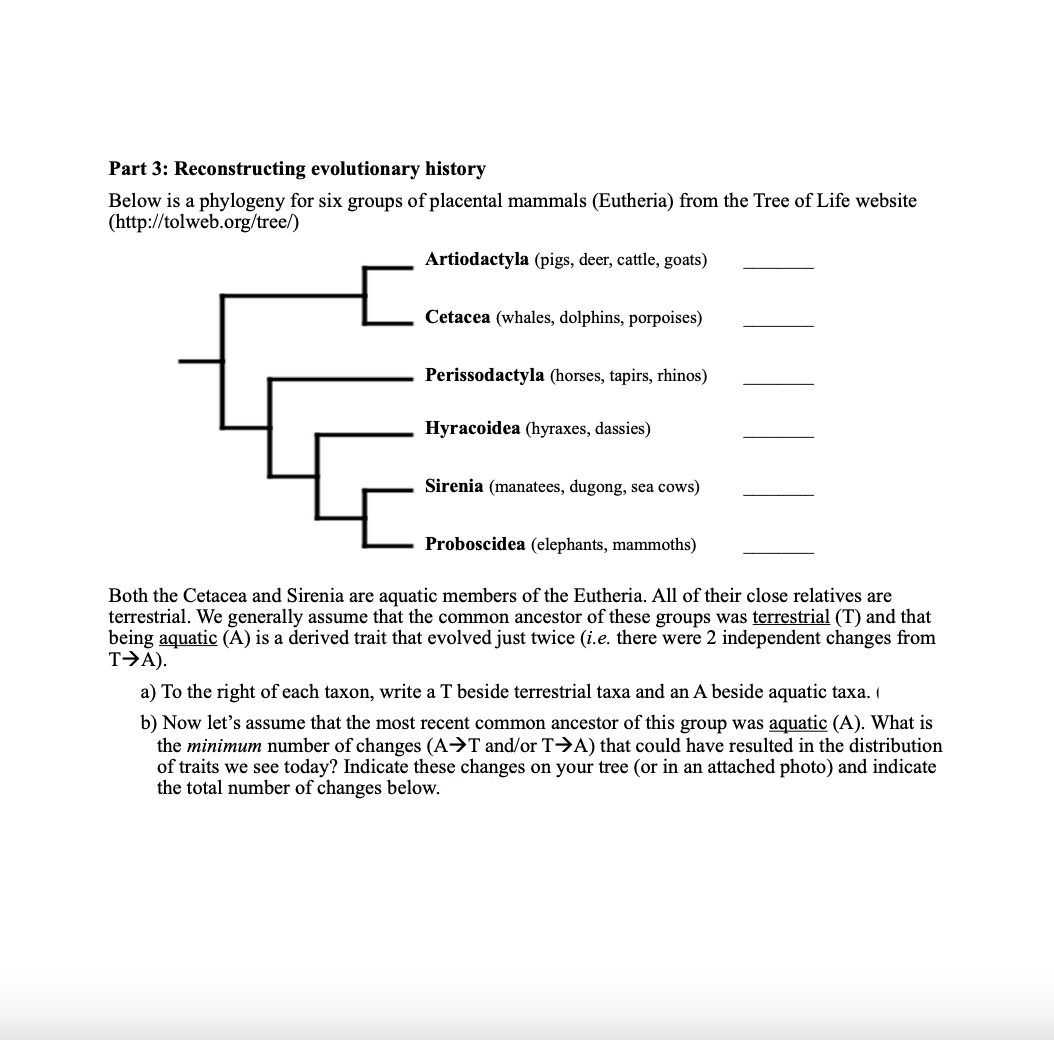Human Heredity: Principles and Issues (MindTap Course List)
11th Edition
ISBN:9781305251052
Author:Michael Cummings
Publisher:Michael Cummings
Chapter19: Population Genetics And Human Evolution
Section: Chapter Questions
Problem 25QP: Genomics and Human Evolution The Denisovan genome contains sequences that originated from an unknown...
Related questions
Question

Transcribed Image Text:Part 3: Reconstructing evolutionary history
Below is a phylogeny for six groups of placental mammals (Eutheria) from the Tree of Life website
(http://tolweb.org/tree/)
Artiodactyla (pigs, deer, cattle, goats)
Cetacea (whales, dolphins, porpoises)
Perissodactyla (horses, tapirs, rhinos)
Hyracoidea (hyraxes, dassies)
Sirenia (manatees, dugong, sea cows)
Proboscidea (elephants, mammoths)
Both the Cetacea and Sirenia are aquatic members of the Eutheria. All of their close relatives are
terrestrial. We generally assume that the common ancestor of these groups was terrestrial (T) and that
being aquatic (A) is a derived trait that evolved just twice (i.e. there were 2 independent changes from
T→A).
a) To the right of each taxon, write a T beside terrestrial taxa and an A beside aquatic taxa. I
b) Now let's assume that the most recent common ancestor of this group was aquatic (A). What is
the minimum number of changes (A→T and/or T→A) that could have resulted in the distribution
of traits we see today? Indicate these changes on your tree (or in an attached photo) and indicate
the total number of changes below.
Expert Solution
This question has been solved!
Explore an expertly crafted, step-by-step solution for a thorough understanding of key concepts.
Step by step
Solved in 4 steps with 2 images

Knowledge Booster
Learn more about
Need a deep-dive on the concept behind this application? Look no further. Learn more about this topic, biology and related others by exploring similar questions and additional content below.Recommended textbooks for you

Human Heredity: Principles and Issues (MindTap Co…
Biology
ISBN:
9781305251052
Author:
Michael Cummings
Publisher:
Cengage Learning

Biology: The Dynamic Science (MindTap Course List)
Biology
ISBN:
9781305389892
Author:
Peter J. Russell, Paul E. Hertz, Beverly McMillan
Publisher:
Cengage Learning

Biology Today and Tomorrow without Physiology (Mi…
Biology
ISBN:
9781305117396
Author:
Cecie Starr, Christine Evers, Lisa Starr
Publisher:
Cengage Learning

Human Heredity: Principles and Issues (MindTap Co…
Biology
ISBN:
9781305251052
Author:
Michael Cummings
Publisher:
Cengage Learning

Biology: The Dynamic Science (MindTap Course List)
Biology
ISBN:
9781305389892
Author:
Peter J. Russell, Paul E. Hertz, Beverly McMillan
Publisher:
Cengage Learning

Biology Today and Tomorrow without Physiology (Mi…
Biology
ISBN:
9781305117396
Author:
Cecie Starr, Christine Evers, Lisa Starr
Publisher:
Cengage Learning

Biology 2e
Biology
ISBN:
9781947172517
Author:
Matthew Douglas, Jung Choi, Mary Ann Clark
Publisher:
OpenStax

Biology: The Unity and Diversity of Life (MindTap…
Biology
ISBN:
9781305073951
Author:
Cecie Starr, Ralph Taggart, Christine Evers, Lisa Starr
Publisher:
Cengage Learning